Archive for February, 2013
Sunday, February 24th, 2013
By Carolyn Yeager
copyright 2013 Carolyn Yeager
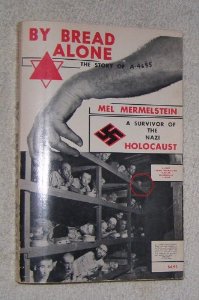
First edition of Mermelstein’s book came out in 1979.
According to our esteemed correspondent Attila Kovacs, his reading of Mel Mermelstein’s survivor story reveals no mention of the famous Elie Wiesel, even though the book first came out in 1979 when Wiesel and his own story was already well-known among the general public.
The first edition [right] was 264 pages, published by Crescent Books. In 1981, a second edition of the book [below right] came out, following Mermelstein’s dispute in 1980 with the Institute for Historical Review (IHR) over his claimed proof that even a single Jew was gassed at Auschwitz.
The second edition of By Bread Alone was published by the “Auschwitz Study Foundation” and retains the same cover design, but with some new text added referring to the author’s successful lawsuit. It is expanded to 290 pages from 264 pages in the first edition – an increase of 26 pages to include the lawsuit story. The new cover texts reads:
who, in 1981, filed a lawsuit for 17 million and 50 thousand dollars against the Institute for Historical Review, a Torrance, California-based organization of revisionists and pseudohistorians who claim the Nazi Holocaust is nothing but a hoax, a Zionist plot.
The only other change is that the price that was printed in red on the lower tab on the right side has been removed.
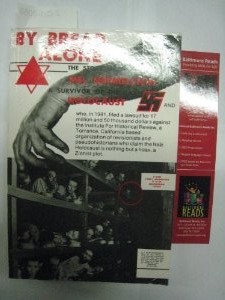
2nd edition of book came out in 1982.
How well-known was Elie Wiesel in 1979?
It was 1978 when Wiesel was appointed by President Jimmy Carter as chairman for the Presidential Commission on the Holocaust (later renamed US Holocaust Memorial Council), indicating that he was at that time a recognized ‘authority’ on all things ‘holocaust.’ In fact, Wiesel claims that it was he who coined the term ‘Holocaust’ for the Jewish ‘Shoah,’ even though he doesn’t like the term. Typical Wieselspeak. That’s a term I just coined!
In 1979, Wiesel’s 15th book was published, the title being A Jew Today, a collection of essays, letters and diary entries weaving together all the periods of his life up until then. To put out a book such as that, one has to have a substantial following. Fifteen books by 1979! It is unimaginable that a Hungarian ‘survivor’ such as Mel Mermelstein would not be familiar with Elie Wiesel.
Attila Kovacs tells us what he discovered reading Mel’s book
In his own words he writes:
First, I must admit that reading the book the second time was somewhat of a struggle as there were so many confusing items, too many irrelevant, random photos, and the quality of the story left a lot to be desired from a strictly literary sense. The author jumps around as to his own identity as a Jew, (he is) a Hungarian Jew, a Czechoslovak, a Karpatho-Rus, and a Czech – to the point that I was confused as to what his main claim was as to nationality, mother tongue, ethnic origin.
But as to his being Hungarian, there is little doubt:
Lajos, his brother, Magda, his sister, and friends Joncsi (probably just a typo as Jancsi is a common Hungarian name), Pista, and Moric are all Hungarian names; in this regard, Etu may be Eti. His labor camp documents all say Ungarn, which is Hungarian in German. In addition, he refers to his hometown as Munkacs, which is Hungarian. It is telling in that the author did not use the Czech or Slovak spelling of Mukacevo or Mukaceve or the Ukrainian/Russian name of Mukacheve. Then on p. 17, he calls out to his father as ‘apu’ which is Hungarian for father.
As such, one has to assume that his mother tongue used in the home and in Munkacs and in the camps with other Hungarian Jews is Hungarian. In “Youtube” videos showing life in Munkacs in the 1930′s – the Jewish schoolchildren singing, a large town center wedding, and street conversations of the Jews are practically all in Hungarian.
Since in Elie Wiesel’s own “Youtube” video of his return visit to his hometown of Sighet he is speaking Hungarian with the old town folk, it seems that Moric (Mel) and Elie would have a lot in common and would converse in Hungarian at Buchenwald.
Yes, you would certainly think so. But one can get the impression that Wiesel is unable to converse comfortably in Hungarian because he often refuses to speak it in public. As he did with Nikolas Grüner in Stockholm. However, you would know this better than I.
The only reference in the book to Elie Wiesel is on page x, prior to the Forward, where it [quotes] a statement made by Professor Elie Wiesel of Boston University. So apparently the author knew of Professor Wiesel at the time he wrote the book.
There is a mention on p. 195 of “walked from one barracks (at Buchenwald) to another until I found Elijah, a frail bent youngster from Sighet.” There were a couple of other name mentions of Elijah, but nothing other than the name. So if this was indeed Elie Wiesel, one would think that the author would brag about this important Holocaust celebrity or their common roots, or their common experiences in the Munkacs-Sighet Jewish community, or about what they did together in Buchenwald especially with respect to the famous Buchenwald Liberation photo.
Yes, indeed. “Elijah” cannot be Elie Wiesel. For one thing, Wiesel was not frail and bent. The man he purports to be himself in the Famous Buchenwald Lie-beration Photo on Mel’s book cover is not frail looking at all. (Of course, I should hardly mention that since it’s been proven not to be Elie Wiesel.) But also, photos of Elie Wiesel in France from July-Sept. 1945 onward show a sturdy, vigorous, smiling lad with a head full of longish black hair. Plus Elijah was not an uncommon name amongst the Orthodox Hasidic sect of Hungarian Jews, and some from this sect were in the camp.
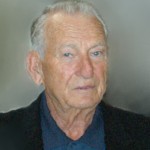 Does Mermelstein give many dates in his book? According to this source, he arrived at Buchenwald on or about February 10, 1945, he remained in the camp until it was liberated by American troops on April 11, 1945. That is only a 2-month stay. He was born on Sept. 25, 1926, making him exactly 2-years older than Elie Wiesel. He is now around 85. (recent photo of Mermelstein at left)
Does Mermelstein give many dates in his book? According to this source, he arrived at Buchenwald on or about February 10, 1945, he remained in the camp until it was liberated by American troops on April 11, 1945. That is only a 2-month stay. He was born on Sept. 25, 1926, making him exactly 2-years older than Elie Wiesel. He is now around 85. (recent photo of Mermelstein at left)
The same source also states this important information: In none of the numerous newspaper interviews he gave prior to 1980 (that we were able to discover) did he make any mention of seeing anyone go into any gas chamber [at Auschwitz-Birkenau]. Similarly, Mermelstein makes no mention of seeing his mother and sisters enter any building or “gas chamber” in the first, 1979 edition of his detailed memoir, By Bread Alone (written before the reward offer).
By the way, the liberation photo is only mentioned on p. 223. Less than one solitary page devoted to the cover picture which shows the author in the upper, most distant spot in the photo. Oh, well.
This confirms my theory in the previous article that 1) it did not mean as much to be in this picture prior to the identification of Elie Wiesel in it, and 2) Wiesel was not identified in it until 1983, after both editions of Mermelstein’s book had been issued. Even though Mel used the picture on the cover of both editions (without the standing man), it was probably only to prove that he was there and that it was as bad as he said it was. That the photo without the standing man was used on both editions also proves that it was not a mistake or an oversight; if it were it would have been corrected on the 2nd edition (unless, of course, this was a real low-budget operation and making a change on the cover was cost-prohibitive).
A can of worms has been opened here, there is no doubt about it.
What is most interesting is the disclaimer on page iv of the book, which I quote: “About the Characters in This Book – Though the characters in this story are real, I felt their names had to be changed to protect their privacy. I have not consulted with any of the survivors mentioned here, because I know how some might feel if the story of their part in the Holocaust were brought to them once again to be dealt with.”
Wow! Go figure then: why he would use his own name rather than a fictitious name; not want to fact check with known survivors; be concerned about privacy when others had written their own books (cannot recall how many in the photo have written their own books about Buchenwald and/or Auschwitz, etc.)
I don’t know of any book by anyone who was actually there; a lot of fraud is involved with this photo. But nevertheless, he certainly would not have changed the name of Elie Wiesel, since this man had already made his own experiences at Auschwitz and Buchenwald very well known. Mel could not speak of Elie Wiesel in Buchenwald because he never met or saw such a person there! Just like Nikolas (Myklos, Michael) Grüner, Mel Mermelstein was actually in Buchenwald (although he lies about what happened to his family and others) and thus his silence on Elie Wiesel completely refutes the testimony of Wiesel.
Nikolas Grüner and Morik Mermelstein are in the Buchenwald Lie-beration photo, but the fraud known as Elie Wiesel is not.
The author, Mr. Moric Mermelstein, does NOT mention or say anything about who (names or descriptions) was with him in the photo of barracks 56 on April 16th around noon.
Query: Whether or not an author in an iconic photo of yesteryear would not mention that in the old grainy middle school team photo the fact that Michael Jordan was in fact the scrawny, short but smiling kid at the end of row two sandwiched between the team water boy and a forgotten assistant coach?
Yes, Attila is so right. If such an “iconic” person were with you during a period of your life that you are writing about, and even in the same room — and a photograph existed that showed it — well, anyone would certainly mention it. There can be no doubt that Mr. Mermelstein’s book has given us more proof that Elie Wiesel is not in the Buchenwald picture. I don’t suppose Mel will be too pleased with helping our revisionist cause, but so he has. Thanks Mel! You won a battle, but you’re losing the war.
Wednesday, February 13th, 2013
by Carolyn Yeager
The interview with psychiatrist Max Hamburger that appeared in the March 2012 Dutch magazine Aanspraak was translated into English for me by Hasso Castrup. Some things that Hamburger said are revealing of his overall honesty when it comes to his statements about “the Holocaust.” Being a “holocaust survivor” who appears in the famous photograph is, after all, his only claim to fame.
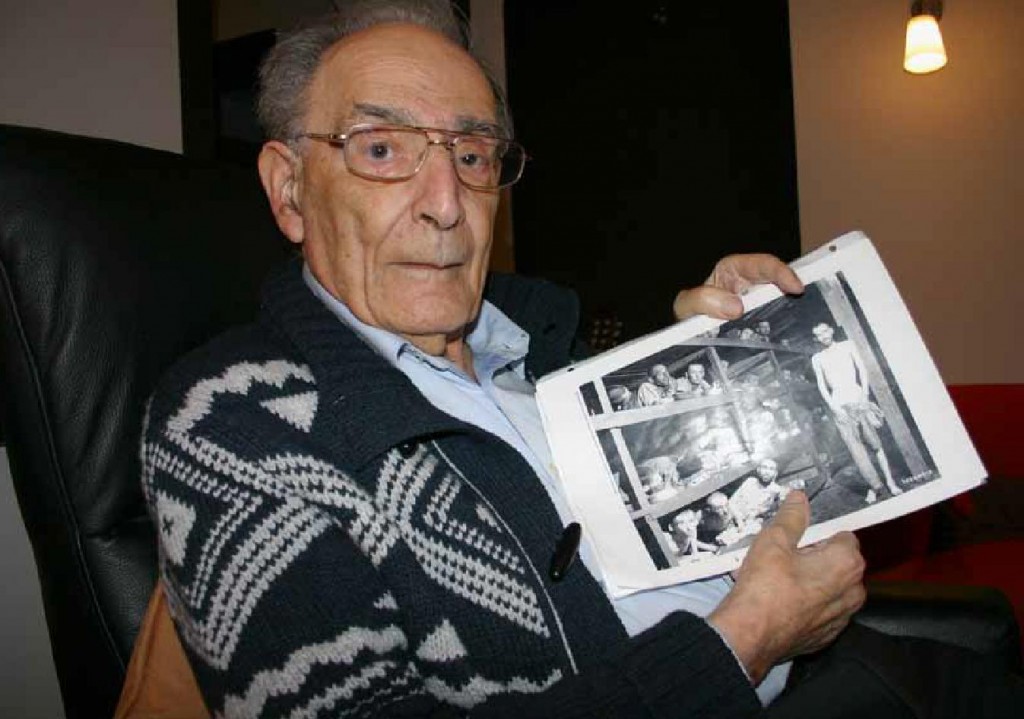 Max Hamburger in 2012 pointing to himself in the Famous Buchenwald Lie-beration Photo from 1945 (Source: Aanspraak magazine)
Max Hamburger in 2012 pointing to himself in the Famous Buchenwald Lie-beration Photo from 1945 (Source: Aanspraak magazine)
I’ve already reported in a previous article (scroll down to end) that his father was an Amsterdam diamond merchant, Hartog Hamburger, who died from a bizarre accident when Max was only four years old. His mother, a fashion designer, worked even harder after that and often left him with his grandparents. When Max was ten, his brother died of leukemia, leaving Max alone with his mother. This is quite a lot of trauma in the first ten years of life, which couldn’t help but leave a mark on his psyche.
He says his brother’s death is what inspired him to study medicine, beginning in 1938 when he was 18. But in 1942, further public education was denied to him because he was Jewish. His job with the Jewish Council (Judenrat) allowed him to remain immune to deportation to Westerbork by getting a special stamp on his Ausweis (ID). In the summer of 1942, he went to work as an intern at the New Israelite Hospital, where he learned that when the substance ‘Pyrifer’ is injected intravenously it will cause high fever similar to what one gets with malaria or typhoid. Hamburger began injecting this into the Jewish patients so they would be declared unfit for deportation.
This, of course, raised suspicion among the Germans and Hamburger says in June 1943 the New Israelite Hospital was raided, in order to be emptied. He and other medical personnel hid patients under laundry and in the morgue, and led seriously ill patients into hiding (?). He is proud to describe himself as part of the Resistance and says he was later awarded with a memorial cross because of it. He tells a story that describes how in August 1943 he once again escapes deportation, but I’m not repeating it because there is no way to assure it’s true.
Working with the Resistance
He then moved to the Jewish Handicapped (Asylum) at Weesperplein, where he and other doctors again tried to”save” as many patients as possible by declaring them ill with contagious diseases. He says at the Portuguese-Israelite Hospital people in mixed marriages were to be sterilized. Along with most of the staff, he refused to cooperate and went through a hidden door into a neighboring villa and went into hiding. He and his girlfriend were married by a rabbi; they were both fully into the Resistance now. His mother was also brought to where he was, but she quickly hid herself elsewhere.
He says that “shortly afterwards we were betrayed and arrested, interrogated and deported to Westerbork. My mother was also betrayed.” On Sunday, February 6, 1944, he saw her for the last time in the penal barracks at Westerbork. They fell into each other’s arms and cried. But then … “In Auschwitz I met a fellow radiologist who was deported together with her. He told me that my mother was gassed on March 6, 1944. I arrived there on February 10, 1944 (his 24th birthday, but he doesn’t mention it), but did not see her again.”
Since we know there were no gassings at Auschwitz – this is a dead giveaway that he’s telling a big lie, although he’s putting the lie in the mouth of an unnamed “fellow radiologist.” This is a trick that is used often by so-called witnesses and “survivors.” The so-called informant should always be named; if they can’t name the exact source of the information, they should not be believed.
At Auschwitz, he at first failed, then succeeded in becoming recognized as a doctor. He began on a work detail where he says he was “poorly dressed in the icy cold damp weather, the work meant a maximum survival of 3 months.” (We hear so often that the life expectancy was “3 months,” but why did most inmates not only live until liberation, but into old age after it? Hamburger himself is 93 years old – Feb.10, three days ago, was his birthday.) As a doctor, he supervised the cleaning of the barracks during the day, in the afternoon handed out soup, evenings he did lice control. What’s so hard about that? Yet he says that in April he developed a fever, and on May 1st managed to avoid the medical inspection (a strange story of ‘luck’) in order to be included in a transport of Hungarian “forced” laborers headed to Silesia. He says this “saved his life” (considering his 3 months were almost up, don’t you know).
According to this, Hamburger was at Auschwitz from Feb. 10 to May 1, 1944 – a little less than three months. This was the usual length of quarantine at Birkenau for those who were then sent to other camps as labor. During the 2 to 3-month quarantine period the inmates did not work, so I do think his account has quite a bit of invention in it so as to not sound like quarantine. His mother would also have been in quarantine and he would not have seen her there, being the men and women were strictly segregated into separate camps. This is the usual situation from which “survivors” claim their relatives were gassed, the information so often coming from a nameless fellow inmate; sometimes from a “sadistic guard.”
After Auschwitz, the story gets more confusing
The train took them to Gross Rosen, where an old factory was assigned as their hospital. He says “we” had to vaccinate everyone against typhus in February 1945. Their only hope were reports of advancing Russians and Americans, which they knew of because a fellow prisoner secretly listened to the radio. At the evacuation of the camp they had to walk in the snow to the Czech Republic. From there they were taken by train from Prague to Flossenbürg camp in Bavaria.
According to USHMM, Gross Rosen camp was evacuated in early February ’45 and “about 40,000” from the main camp and sub-camps had to march west. This is a lot of inoculation to be done in a few days. But more important, the 9-month period he spent at Gross Rosen between May 1944 and February 1945 is blank. May 1944 coincides with the time of the large Hungarian deportation to Auschwitz; Hamburger says he was with a Hungarian labor unit that had already been to Auschwitz and sent out from there. Would not the new arrivals also have been sent out from there in like manner? From here on, his narrative remains very sketchy, and is mostly made up of vague horror stories.
He says, “The camp guards were shooting prisoners who were their live targets in the white landscape. Daily there were death sentences and prisoners were hanged before our eyes.” Yet the prisoners were needed to work in the quarries and Messerschmitt factories … and they had been innoculated in February against typhus, no doubt at some expense. So why would they be wasted as target practice for the guards? This is when survivor stories become really unbelievable. At the beginning of March 1945, he says they were deported to Ohrdruf, a work camp of Buchenwald. “Here were bombproof underground factories for assembly of V-weapons. After underground explosions with dynamite, we were to remove the big stones from the corridors by small-gauge trains.” But he doesn’t stay there. “We had to walk for four days and nights 80 km (approx. 40 miles) through the snow to Buchenwald.” Although he says he was practically “in a coma,” he’s clear about the dates and distances.
“On 11 April 1945, Buchenwald was liberated by the American army. Five days after the liberation our well-known picture (was taken). I lie down there, fourth from the left. As I lay there someone advised me to go to the hospital, because I otherwise would not survive. “If they do not record you, you go ‘under the grass.’ When an American goes by and sees you lying, he makes sure that you get recorded. And so I went. With DDT powder I was lice free. The lice and I got U.S. baby food! For me THAT was liberation. During a night in the hospital, I knew: ‘If I fall asleep, I’ll never wake up and I won’t be able to testify to what happened to us.’ I fought that night to the utmost against sleep and thereby I survived.”
From the beginning of March to April 11, Hamburger has nothing to say except that he spent 4 days walking from Ordruf to Buchenwald and that he was in the photograph taken on April 16. He doesn’t give the date that he arrived at Buchenwald. What he tells can be picked up from any number of accounts of the time period. Can we believe he was even at Buchenwald? Why was he in that barracks #56? How long was he there? Why did “someone” have to tell him to go to the hospital 5 days after the Americans arrived? All very implausible since he was a medical professional.
But beyond all this is the fact that the figure he says is him is indeed a retouched copy of the figure in the row above, 3rd from the left. He doesn’t claim any relationship to that person, who has been identified (inaccurately) by Yad Vashem Museum as Yehuda Doron or Yaakov Marton. This famous photograph has been proved to be a composite photo created by a U.S. military intelligence department to be used in the ongoing propaganda war against Germany and Hitler’s Third Reich, so everything about it is suspect.
The rest of what Hamburger said in the interview does not apply to the questions I have. Again, my primary question is: When did Max Hamburger first say he was in that photograph? Like so many others, it was not at liberation, nor in the years following. In fact, there is no information that I have found as to when this did occur. Why? Because it must be recent – too recent.
Concluding thoughts
In 1945, Max was 25. He wrote that he and the loyal wife he married when he was 22 were divorced sometime around or after 1957, and he is now with his third wife.
“For a long time I have been a psychiatrist and I have helped many war victims thanks to my own experiences. Until I could no longer afford to listen to them. Unfortunately I never found a psychiatrist who could help me. I regret that I was a bad partner in the previous marriages, but that’s because I was in the grip of the past I had lived through. I find it annoying when people make demands on me and I can get angry.”
I bet he could sure get angry with me! I am making demands on Max Hamburger to fill in the blanks in his “holocaust survivor” story. I don’t have any reason to doubt the early part of his story but, starting with his and his mother’s arrival at Auschwitz, there is much to question.
He is, from all appearances, a loyal Jew with the typical Jewish desire to avenge the “wrong” done to his people and the interruption and pain in his own personal life. Telling lies to accomplish this is not, therefore, a wrong in his eyes. A wrong for a wrong is, for Jews, a fair exchange … nothing to be ashamed of. This may even be how he counseled his patients.
2 Comments
Category Featured | Tags: Tags: Auschwitz, Buchenwald, Dutch Resistance, Gross Rosen camps, holocaust survivor, Max Hamburger, photo forgery, Westerbork,
Social Networks: Facebook, Twitter, Google Bookmarks, del.icio.us, StumbleUpon, Digg, Reddit, Posterous.
Wednesday, February 6th, 2013
By Carolyn Yeager
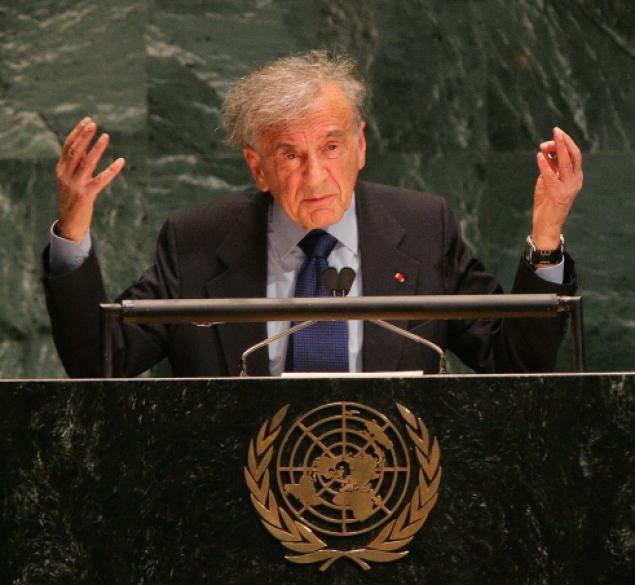 Elie Wiesel at the United Nations in January 2005. This is the photo accompanying his gun control comments in the New York Daily News. If he looked this bad then, what does he look like now, 8 years later. Is that why we don’t see him any more?
Elie Wiesel at the United Nations in January 2005. This is the photo accompanying his gun control comments in the New York Daily News. If he looked this bad then, what does he look like now, 8 years later. Is that why we don’t see him any more?
If Massacre of 20 children in Newtown doesn’t bring gun control, what will? by Elie Wiesel
So reads the headline in the New York Daily News on Dec. 17, 2012 – just three days after the Sandy Hook, CT, shooting event. Okay, I’m pretty late in commenting on this Elie Wiesel story but I just now happened upon it. The Daily News is as Jewish as it gets for a “mainstream” paper and we know (or can see) that removing American’s constitutional gun rights is part of the Jewish agenda that it is promoting.
We can see that the Jewish Mafia that runs this country put their big gun Elie Wiesel on it from the get-go. Even though Wiesel’s byline is attached to this story (he’s a journalist, remember), I suspect the words have been partially scripted for him and he just adds his own flavor and style to them. The news story reads (my comments in blue):
Disbelief, horror, revolt: This is what we all felt when the news arrived. By its magnitude and cruelty, it surpassed everything else. We were not ready for it. Earlier tragedies should have immunized us. But they didn’t. Not to this violence, to this bloodshed. Oy vey, The Children!
A young man assassinates his mother with her own weapons. Then, he goes to an elementary school and murders 20 children, one after the other, firing more and more bullets into their small bodies. Just three days after the event, he is sure of this. The story was prepared ahead of time, and was given out almost one hour after the deed supposedly occurred. Wiesel, of course, doesn’t question any of it.
Why?
The need, the desire to understand is as strong as the pain itself. Wiesel’s trademark is ‘trying to comprehend the evil.’
Propaganda inserted here:
Today, the Daily News is launching a petition to call for the ban of assault weapons. To participate, print and send in the form at the bottom of this page, or SIGN ONLINE HERE.
Somehow, in spite of the lost lives that we read about in street fights, in poverty-stricken neighborhoods, in faraway war regions such as Syria and Afghanistan, we were unprepared to see this kind of evil in action. Since there is obvious evil everywhere by highly armed men, especially in Gaza, ,Elie has to help us to see that THIS is an even worse evil. It’s always about evil, and Elie is the one we can depend on to point it out to us.
EDITORIAL: THE NRA’S COMEUPPANCE
HAMMOND: HOW NEW YORK CAN LEAD THE WAY … more propaganda
What does it say about the world, the culture we live in, the ideas we cherish and the education we receive? Yes, what? He always asks the question; never gives the answer.
In the most passionate address of his life, President Obama spoke for all of us when he said that his heart was broken. So was ours. Oy vey. Other areas of our being were also affected. If the death of one child is a tragedy, the murder of 20 is a scandal of outrageous proportions. Oy vey!
Beliefs and certainties are to be reexamined, habits and values reevaluated. In the face of so much pain and mourning, we must not ignore the question: Where did society go wrong? What made humanity so frail, so blind? Where did education fail? What does such an outburst of anger say about our generation’s hopes and ideals? Oy vey! But where are the answers?
In other words: Is there anything we can learn from this event? That all murder is evil but that of children is seven times seven more? That the ease of acquiring a weapon is no longer acceptable. If this tragedy does not produce universal gun control, what can and what will? What else do we need for preventing further horrors such as this? Oy vey. Finally an answer: We should no longer be able to acquire weapons. That will do it.
And what do we know about the perpetrator? We know he didn’t finish college and struggled socially. But what did he do in his spare time? What books did he read? What music did he listen to? What was he dreaming about? What made him laugh or weep? Double Oy vey.
We must discover, to the extent possible, what his secret ambitions were. Why? We must remember: He was not a stranger from another planet.
He was one of us. Oy Vey!! Was he Jewish?
Wednesday, February 6th, 2013
By Carolyn Yeager
copyright 2013 carolyn yeager
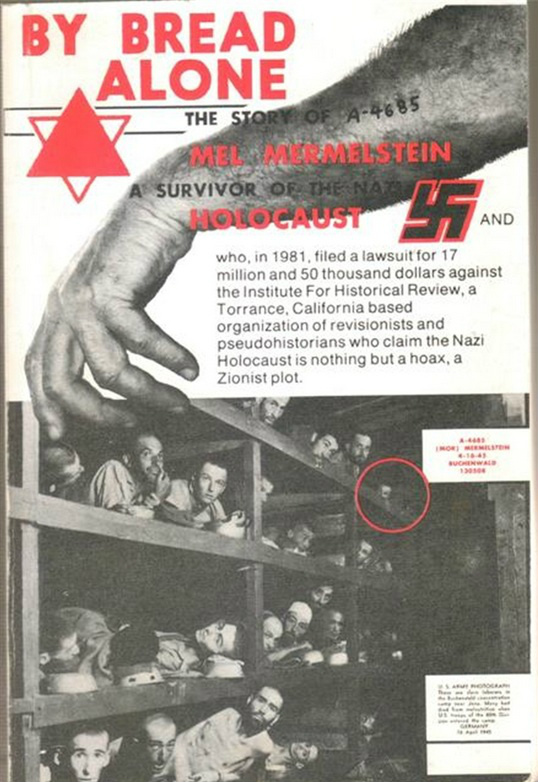 Once again, a helpful commenter on this website has brought us an important discovery. Thanks to Attila Kovacs, I looked up Mel Mermelstein‘s 1979 “survivor memoir” titled By Bread Alone: The Story of A-4685 and discovered just what Kovacs reported — that the Famous Buchenwald Liberation Photo that is on the cover of the book (with Mel’s face circled in red) does not contain the tall standing man. In Kovacs’ words: “What is not shown on the cover photo is the tall man standing on the right leaning on the post. The post is there, but why then not the man standing?” Good question.
Once again, a helpful commenter on this website has brought us an important discovery. Thanks to Attila Kovacs, I looked up Mel Mermelstein‘s 1979 “survivor memoir” titled By Bread Alone: The Story of A-4685 and discovered just what Kovacs reported — that the Famous Buchenwald Liberation Photo that is on the cover of the book (with Mel’s face circled in red) does not contain the tall standing man. In Kovacs’ words: “What is not shown on the cover photo is the tall man standing on the right leaning on the post. The post is there, but why then not the man standing?” Good question.
Another helpful reader supplied the larger image of the book cover, from Google Images! I confess, I never thought to look there. Thanks Simon! Now you can even more clearly see the post on the right edge of the picture, with no one standing beside it – just dark, empty space.
Kovacs continues, “On page 208 of the book, the same photo is reproduced, but magically the tall standing man is included in this photo. What the heck is going on?”
What seems to be going on can be explained this way: Elie Wiesel was not identified in that photograph until the 1980’s. As I have written elsewhere, it was a decision made to increase Wiesel’s chances for a Nobel Prize. He wanted one, and his supporters began in 1983 to lobby the Nobel committee and plant news stories that he was being considered for either the Peace Prize or the Literature Prize. In 1986, the Peace Prize was awarded to him. The first thing he did as follow-up was to travel to Yad Vashem holocaust memorial in Israel to express his appreciation and get photographed in front of a wall-size blow-up of that famous picture.
Why are these dates important?
Mermelstein’s book came out in 1979; Elie Wiesel was first identified in the photo around 1983, so Mel would not have been aware that one of the men laying just two rows below him was (supposed to be) Elie Wiesel. He would also not remember a man standing naked when the photograph was taken … since there wasn’t one. When he saw this picture for the cover, it would have looked right to him. An editor may have added the pictures inside the book, without realizing the discrepancy with the one on the cover. We have already seen evidence of how most people miss sensing anything wrong when viewing the picture without the standing man.
An alternative explanation could be that the standing man was too dominating in the picture, taking visual attention away from Mel the author, who was way back in the upper bunk, barely visible. If this were true, however, it would verify that there are indeed two versions of the picture known — one with and one without the “naked” man. But also, since it has already been proven that this standing man was added by “photo composite” techniques known at the time, we know that he was not in the original photograph taken on that day.
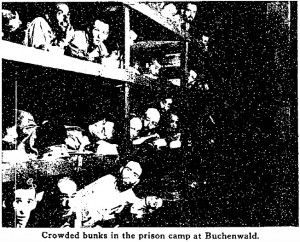 This image (left) from a story in the New York Times, May 6, 1945 is exactly the same as what is on Mermelstein’s book cover. We can see the post, everything is there except the standing man next to the post. The man has not been ‘removed’ – he was never there. Those who want to argue that he was removed should provide an explanation of why and how that was done if they want us to believe it.
This image (left) from a story in the New York Times, May 6, 1945 is exactly the same as what is on Mermelstein’s book cover. We can see the post, everything is there except the standing man next to the post. The man has not been ‘removed’ – he was never there. Those who want to argue that he was removed should provide an explanation of why and how that was done if they want us to believe it.
Does Mermelstein write in his book about meeting Elie Wiesel at Buchenwald?
I can’t find a readable version of the book online, but since Attila Kovacs has a copy we can ask him: What does Mermelstein say about Elie Wiesel being in the famous photo with him? If he says nothing, that is further proof of Wiesel’s chicanery. In looking at reviews of this book, I don’t see Elie Wiesel’s name anywhere. I am under the impression that the book is more about Mel’s lawsuit against the Institute for Historical Review than about his experience in the camps. So we’ll leave it here for now and see what more Attila Kovacs can tell us.
UPDATE: Feb. 10
For those who want to see a better quality image, this was taken from Winston Smith Ministry of Truth website. He obtained an original NYTimes Magazine from May 6, 1945. However, the man 2nd from the right in the upper row (to the left of Mermelstein) is not the same face or person as the standing man, as some want to believe.
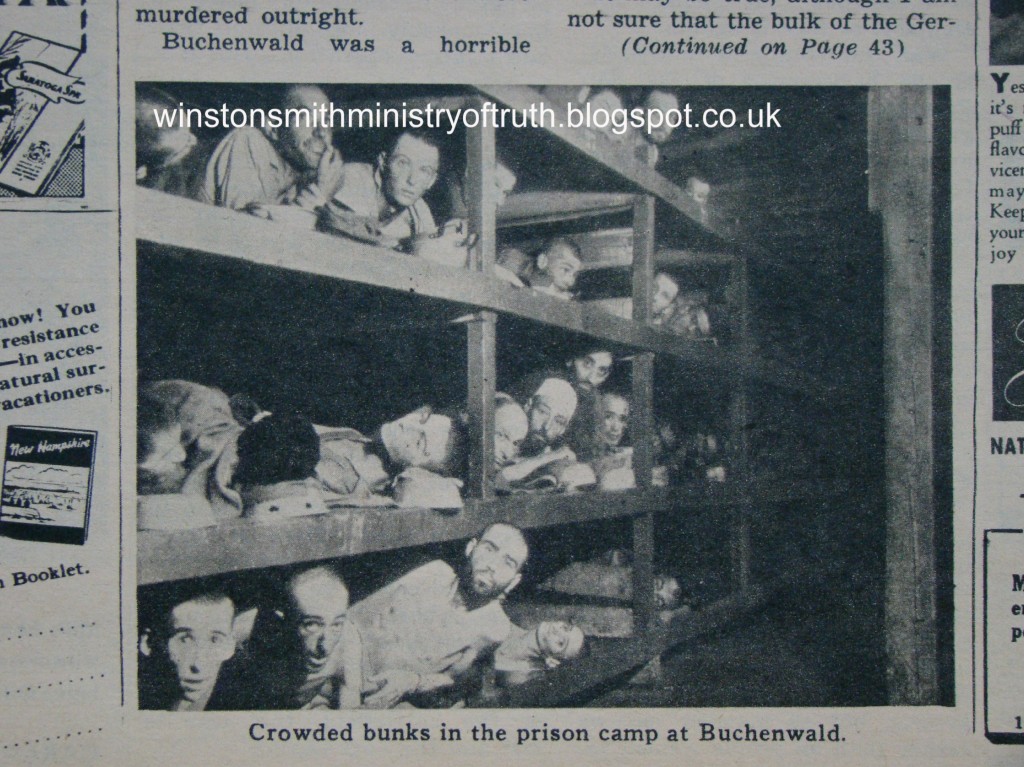
 Does Mermelstein give many dates in his book? According to this source, he arrived at Buchenwald on or about February 10, 1945, he remained in the camp until it was liberated by American troops on April 11, 1945. That is only a 2-month stay. He was born on Sept. 25, 1926, making him exactly 2-years older than Elie Wiesel. He is now around 85. (recent photo of Mermelstein at left)
Does Mermelstein give many dates in his book? According to this source, he arrived at Buchenwald on or about February 10, 1945, he remained in the camp until it was liberated by American troops on April 11, 1945. That is only a 2-month stay. He was born on Sept. 25, 1926, making him exactly 2-years older than Elie Wiesel. He is now around 85. (recent photo of Mermelstein at left)







